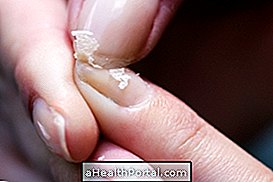Insulin can be applied with a syringe or through a pre-filled pen, however, the syringe remains the most common and cheapest method. In either case, the insulin should be injected into the fat layer under the skin, where it will be absorbed slowly, mimicking the production of the substance by the pancreas.
In addition, insulin can also be introduced into the body by an insulin pump, which is a small, portable electronic device that releases insulin for 24 hours. Read more about how the insulin pump works.
1. Apply insulin with syringe

There are several sizes of insulin syringes, ranging in capacities from 0.3 to 2 ml, depending on the range of insulin units a person needs to make.
Generally, each ml can be divided into 100 units, but there are insulins that have 500 units in each ml and therefore, the calculation of the necessary units must always be explained by the doctor, according to the type of insulin and the blood glucose values . Once you know the value to inject, you should:
- Wash hands to avoid contaminating the vial of insulin or carry bacteria into the syringe;
- Place a sterile needle in a sterile insulin syringe ;
- Disinfect the rubber from the insulin bottle, passing a piece of cotton swab with alcohol;
- Insert the syringe needle into the rubber of the insulin bottle and turn the bottle upside down so that the needle is immersed in liquid and does not suck air;
- Pull the syringe plunger until it fills with the correct number of units . Usually, the syringe is divided with several risks which means 1 unit and is marked every 10 units, to facilitate the task;
- Remove the needle and the syringe, re-cap the bottle, if possible;
- To make a fold in the skin, using the thumb and the indicator;
- Fully insert the needle into the fold, at an angle of 450 to 90 °, with a fast and firm movement;
- Push the syringe plunger until all contents are released;
- Wait about 10 seconds and remove the skin needle by loosening the skin fold after removing the needle.
When it is necessary to mix 2 types of insulin in the same syringe, fast-acting insulin should be placed in the syringe and then added to the slow-acting insulin, so no need to change needles. Usually fast insulin is transparent and the slow is whitish, similar to milk. Both insulins should be mixed before aspirating into the syringe, and it is recommended to roll the vials between the two hands instead of shaking.
After application, the needle and syringe should be thrown in the trash or stored in a separate container for later delivery to the pharmacy and recycled. Whenever possible, the needle should be protected with the cap. No syringe or needle should be used in more than one application as it may increase the risk of infection or reduce the action of the drug.
2. Apply insulin with a pen

The pen is a more practical option than the syringe, however it is more expensive and therefore may not be used in all cases. To properly apply insulin using a pen, you need to:
- Wash your hands and have the injection site cleaned. If it is dirty, clean the place with an alcohol swab or gauze;
- Gather all necessary material, which includes pen prepared with insulin cartridge and needle and compress;
- Prepare the amount of insulin you should apply by turning the pen and observing the number on the display. For example if your doctor has indicated that you should take 4 units at dinner, you should turn the pen until the number 4 appears;
- Make a crease in the skin using only the thumb and forefinger, especially on the belly and thigh;
- Insert the needle, between 45º and 90º, with a fast and firm movement. As the needle is very small and only inserted into the skin causes the sensation of a mosquito bite, not being painful and, it should be made a greater angle (90º) the more body fat the person has;
- Push the plunger, or button all the way down to inject the insulin;
- Wait up to 10 seconds before removing the needle from the skin, so that the liquid enters the entire body;
- Loosen the small fold of the skin.
Normally, the application of insulin does not cause pain or cause changes in the skin, however, shortly after the application of the insulin, a small drop of blood can leave, not worrying and can be cleaned with a compress.
Where to apply insulin
Insulin can be applied to the belly, thigh, arm and buttocks and is usually made before eating, such as breakfast, lunch or dinner.

The application to the belly and thigh allows a skin fold to be made, but in the arm, the application can be done without folding when it is performed by the person, because the movement is more complicated.
Its application should always be performed in different places, at a time, to avoid the accumulation of fat and make the skin flaccid in the region, scientifically called lipodystrophy. Read more in: Complication of misuse of insulin.
How to prepare the insulin pen
There are insulin pens that are disposable, which means that after finishing the amount of medicine that is inside the pen, it must be thrown in the trash and, therefore, do not need to be prepared, it is only necessary to turn the pen button up to the desired amount of insulin.
However, most pens need to be prepared as soon as an insulin cartridge is finished, as they can be used over several years, and thus it is necessary to:
- Dismantle the pen by turning;
- Remove the empty insulin reservoir and insert a new vial therein;
- Join the two parts of the pen ;
- Insert a needle into the end of the pen;
- Test the operation and see if there is a small drop of insulin and remove any air bubbles that may be inside the bottle.
After the pen is in place, the patient can use it until the product is finished, however, it is advisable to change the needle daily, so as not to injure the skin or cause infections.























